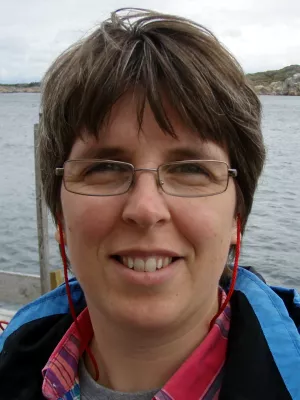
Helena Alexanderson
Professor

Storm chasing : Tracking Holocene storminess in southern Sweden using mineral proxies from inland and coastal peat bogs
Författare
Summary, in English
Severe extratropical winter storms are a recurrent feature of the European climate and cause widespread socioeconomic losses. Due to insufficient long-term data, it remains unclear whether storminess has shown a notable response to changes in external forcing over the past millennia, which impacts our ability to project future storminess in a changing climate. Reconstructing past storm variability is essential to improving our understanding of storms on these longer, missing timescales. Peat sequences from coastal ombrotrophic bogs are increasingly used for this purpose, where greater quantities of coarser grained beach sand are deposited by strong winds during storm events. Moving inland however, storm intensity decreases, as does sand availability, muting potential paleostorm signals in bogs. We circumvent these issues by taking the innovative approach of using mid-infrared (MIR) spectral data, supported by elemental information, from the inorganic fraction of Store Mosse Dune South (SMDS), a 5000-year-old sequence from a large peatland located in southern Sweden. We infer past changes in mineral composition and thereby, the grain size of the deposited material. The record is dominated by quartz, whose coarse nature was confirmed through analyses of potential local source sediments. This was supported by further mineralogical and elemental proxies of atmospheric input. Comparison of SMDS with within-bog and regionally relevant records showed that there is a difference in proxy and site response to what should be similar timing in shifts in storminess over the ∼100 km transect considered. We suggest the construction of regional storm stacks, built here by applying changepoint modelling to four transect sites jointly. This modelling approach has the effect of reinforcing signals in common while reducing the influence of random noise. The resulting Southern Sweden-Storm Stack dates stormier periods to 4495–4290, 3880–3790, 2885–2855, 2300–2005, 1175–1065 and 715-425 cal yr BP. By comparing with a newly constructed Western Scotland-Storm Stack and proximal dune records, we argue that regional storm stacks allow us to better compare past storminess over wider areas, gauge storm track movements and by extension, increase our understanding of the drivers of storminess on centennial to millennial timescales.
Avdelning/ar
- Kvartärgeologi
Publiceringsår
2023-01-01
Språk
Engelska
Publikation/Tidskrift/Serie
Quaternary Science Reviews
Volym
299
Länkar
Dokumenttyp
Artikel i tidskrift
Förlag
Elsevier
Ämne
- Geology
- Climate Research
Nyckelord
- Holocene
- Inorganic geochemistry
- Mineralogy
- Paleoclimate
- Peat
- Scandinavia
- Storms
Status
Published
ISBN/ISSN/Övrigt
- ISSN: 0277-3791

